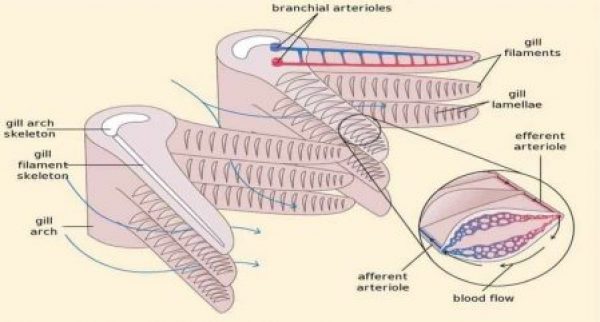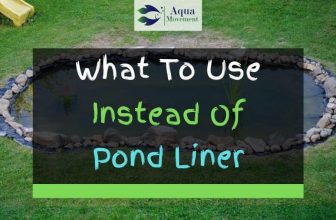5 Ways To Aerate And Oxygenate A Pond
Many people have heard the concept of pond aeration discussed before but might not be fully sure how to do it or even exactly what it is.
That’s not surprising.
Well the concept of aeration is really nothing to be afraid of.
In this fully comprehensive article, we will discuss exactly what aeration is, and will give you a step by step guide on how to aerate a pond.
With this newfound knowledge, you will be well on your way to providing the perfect home for your fish and other aquatic creatures.
Once you see how simple this concept is, you might also realize that most other pond related techniques and concepts are actually simple and based on sound common sense.
Without further ado, let’s get right into it!
Table of Contents
5 Ways Of Pond Aeration And Oxygenation

There are a few different methods of aerating your pond, and each one has its own peculiar advantages and disadvantages.
You might want to focus on just one of these methods, or you can combine a few of them for maximum impact.
Moving water is one of the best, tried and tested ways to oxygenate (i.e. aerate) your pond.
With this in mind, any method that increases the circulation in your pond can help to increase the concentration of dissolved oxygen.
This could be as simple as spraying a jet of water into your pond from a garden hose.
However, although this would work, there are more elegant and practical solutions available to increase the circulation in your water.
1. Pond Pumps
[amazon box=”B002RBGFA4″]
One of the most common ways to do this is by installing a pump in your water.
A pump draws in water from one end, adds kinetic energy and lets it shoot out the other end.
This naturally sets up a circulatory route in the water and increases the level of dissolved oxygen present.
Pumps are generally inexpensive, widely available and are easy enough to assemble. However, you may need to get wet to install it into the bottom of your pond!
There are [amazon link=”B002RBGFA4″ title=”small pumps” link_icon=”amazon” /] available now (for both ponds and fish tanks) whose sole purpose is to aerate the water.
This is in contrast to most pumps; whose main purpose is to move water from one location to another and where water aeration is just a positive side-effect.
Best Pond Pumps – Top 8 Review
2. Pond Fountains And Waterfalls
[amazon box=”B078LZP1LB”]
Another option to increase the movement of water in your pond is to install a fountain.
Of course, a [amazon link=”B078LZP1LB” title=”fountain” link_icon=”amazon” /] is a welcome decorative feature, which can transform your quaint but boring pond into an exciting oasis of tranquility.
But as well as being aesthetically pleasing, the splash of a simple fountain or waterfall, has a beneficial effect on the level of dissolved oxygen in the water.
Although this will result in a capital cost upfront, this could be a very clever long-term investment, as oxygenated water is likely to have health and well-being benefits for years to come.
Best Pond Fountains For Small And Large Ponds
3. Pond Aerators
[amazon box=”B000HASBFE”]
Fountains and waterfalls are example of surface level aerators. They mix the air into the layer of water directly below the surface.
However, there is another category of water aerator known as subsurface [amazon link=”B000HASBFE” title=”aerators” link_icon=”amazon” /]. These supply oxygen directly to the lower layers of water that lie far below the surface.
These are also known as ‘bubblers’. They use a pipe to suck water in from the outside and introduce it into the water in the form of bubbles, hence the common name.
These kinds of systems are very efficient, but they can be more expensive.
For most small ponds, surface aeration is more than adequate to supply the required level of dissolved oxygen.
However, for the largest ponds or industrial sized systems, you might need to use a combination of surface and sub-surface aeration methods.
4. Solar Pumps And Windmills
[amazon box=”B0836KW4LP”]
There are some solutions available for when you want to increase water circulation, but don’t have an electrical connection available.
These sorts of systems are very useful for off the grid circumstances.
For example, you could use a [amazon link=”B0836KW4LP” title=”solar pump” link_icon=”amazon” /] that draws power from the sunlight to increase the water circulation.
You could also set up a simple windmill to turn a water wheel, thereby introducing more oxygen to the water. The possibilities are truly endless when you put your mind to it.
11 Best Solar Pond Pumps and Fountains
5. Pond Plants
[amazon box=”B00YZ6CH0G”]
Moving water is one simple way to increase the level of oxygenation in your pond, but it is not the only way.
A more passive approach is to use the natural oxygenation power of plants. Plants, including [amazon link=”B00YZ6CH0G” title=”aquatic plants” link_icon=”amazon” /], actually take in carbon dioxide and produce oxygen.
This is a very positive symbiotic relationship with fish, as the plants will take in their toxic waste products and produce a much-needed resource.
The choice of plants is crucial. You must carefully select plants which are not only suitable for your climate but are also suitable for your specific pond.
Consider the size and depth of your pond, as well as the naturally occurring vegetation.
Some varieties of aquatic plants are too vigorous for smaller ponds, and they will quickly take over your carefully arranged ecosystem.
However, if you get the selection right, then the plants will steadily increase the oxygen levels in the water, as well as the general health and aesthetic of the ecosystem.
What Is Aeration?
Aeration can be undertaken for a vast array of reasons, but usually it is to increase the health of the pond ecosystem.
But what exactly does aeration mean, you might ask.
Aeration, as you might expect, comes from the word ‘air’. Aeration simply refers to any process which draws more air into the water.
More specifically, it is any process which increases the oxygen content of the water.
Why Do You Need Aeration?
You might wonder, since fish are water dwelling creatures, why is air relevant to them?
Well, like the majority of living creatures on Earth, fish consume oxygen.
Oxygen is needed as part of the respiratory process which allows them to extract energy from the food to consume.
Without oxygen they would not be able to derive any benefit from the calories they take in, so they would not have any energy to fulfill their daily tasks.
Starved of such energy, their bodies would not be able to do their basic functions and would quickly shut down.
This is much the same as what happens to us humans when we are starved of oxygen.
How Aeration Will Help Your Fish To Breath

Fish have gills which allow them to extract dissolved oxygen from the water. These gills can usually be seen as the thin slits on the side of a fish’s head.
In this organ, oxygen can pass across a membrane to their body, to be carried to all the cells of their body.
Gills also allow carbon dioxide, a natural byproduct of respiration, to be passed out of the body, into the external environment.
As you can appreciate, the amount of dissolved oxygen in the water is crucial to the success and survival of all aquatic creatures.
If there is not enough oxygen to go around, then this will have dire consequences on the overall health of the ecosystem.
Oxygen is dissolved in liquid water much the same way as sugar is dissolved in hot water.
Concentration Of Oxygen In Water
Lots of different things can affect the concentration of dissolved oxygen in a body of water. One of the most variable effects is the ambient temperature.
In general, oxygen levels in water decrease as the temperature increases, as more oxygen escapes as a gas.
There are lots of other things that you must factor in as well. Other chemical species in the water can ‘scavenge’ oxygen and therefore reduce the amount that is free for use by living creatures.
The amount of biological activity in the water obviously has a large effect, as this puts a greater strain or demand on the amount of dissolved oxygen present.
In air, oxygen accounts for about 20% (or 400,000 ppm) of the air we breathe. But in normal water, the concentration is much lower, by several orders of magnitude.
In fact, the average concentration of dissolved oxygen in room temperature water is about 6-9 ppm!
With such a low average concentration, obviously even small changes in the availability of oxygen can have drastic effects.
This explains why people go to such efforts to artificially aerate their ponds. Artificial aeration is a proven way to increase the concentration of dissolved oxygen.
This can allow your pond to support much more biodiversity and fish species.
It also means that your fish are likely to be much healthier in general.
Other Benefits Of Aerating A Pond
As well as directly increasing the dissolved oxygen levels, there are a number of important indirect effects that oxygenation can have on your pond.
One of the most important of these is that aeration increase the number of ‘good’ bacteria in your pond.
These biological bacteria help to maintain the balance in your pond by consuming the waste and debris in the pond and turning them into harmless substances.
This improves the overall water quality in the pond, which can have great knock-on benefits for the general health of the pond inhabitants.
With improving water quality, it means the water is clearer and cleaner. This reduces your workload in terms of maintenance and makes for a healthier and happier experience for your beloved fish.
Also, since many aeration methods work by churning and mixing the water, this can help to even out the temperature of the water, thereby reducing incidences of freezing in the winter.
How To Aerate A Pond
Video: “How To Aerate & Oxygenate Your Pond”
If you are just designing a pond, or you want to improve one you already have, there are a number of concrete steps that you can take to oxygenate it properly.
Firstly, you need to install some method for circulating the water. This will usually be pump driven and can come in the form of a waterfall or a fountain.
This will usually require a power source, but there are solar and wind driven types available, if you do not have access to electricity.
Simply install the system, add the relevant filters or strainers, and watch it work its magic.
The next step is to research what types of aquatic plants are suited to your pond.
Then, choose your favorite, head to your nearest garden store, and pick some up. Usually aquatic plants are easy to plant, but you might need some tools.
Conclusion
If you wanted to know ‘how to aerate a pond’ but were too afraid to ask, then this article has shown you exactly how and why to aerate your pond. The benefits of this should not be overlooked.
Increasing the level of dissolved oxygen in the water allows your pond to support more life, improves the water quality and clarity, and makes for a generally healthier local environment.
What’s more, the process of how to aerate a pond couldn’t be simpler.
You can choose active methods (such as installing fountains or waterfalls) or choose a more passive approach (such as by introducing aquatic plants).
Or you could use a mixture of the two. Whatever way you choose to aerate your pond, you can be certain that your fish will thank you for it.




